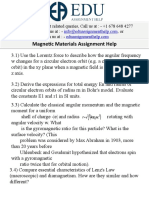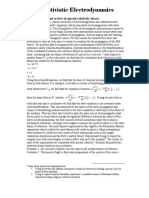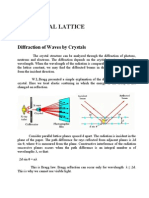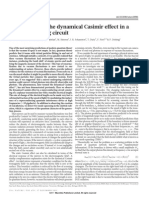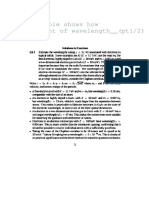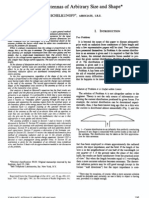Bauer MOD PHY Ch35 (Prob17 22)
Bauer MOD PHY Ch35 (Prob17 22)
Uploaded by
thomaszoy zoyCopyright:
Available Formats
Bauer MOD PHY Ch35 (Prob17 22)
Bauer MOD PHY Ch35 (Prob17 22)
Uploaded by
thomaszoy zoyOriginal Description:
Original Title
Copyright
Available Formats
Share this document
Did you find this document useful?
Is this content inappropriate?
Copyright:
Available Formats
Bauer MOD PHY Ch35 (Prob17 22)
Bauer MOD PHY Ch35 (Prob17 22)
Uploaded by
thomaszoy zoyCopyright:
Available Formats
Chapter 35: Relativity
Bauer's Mod-Phy 2e
35.17. If the lens was situated symmetrically about the mass, there would be indeed be a halo, but since the
alignment is typically not exact, we see arcs instead. Likewise, the curvature is a result of the object’s mass,
so if the object does not have a uniform mass distribution, different rays would be affected non-uniformly.
35.18. In the relativistic limit, velocities must be added relativistically (using the Lorentz transformation) rather
than classically (using the Galilean transformation), as your friend is suggesting. Let F ′ be the frame of
the rocket and F be the frame of the Earth. The torpedo has a speed of u ' = 2c / 3 with respect to the
rocket (frame F ′ ) and the rocket travels at a speed of v = 2c / 3 with respect to Earth (frame F ).
According to the Lorentz transformation the velocity, u, of the torpedo in the Earth’s frame is
= u =
u '+ v ( 2c / 3 ) =
+ ( 2c / 3 ) 12
c.
1 + vu '/ c 2
( )
1 + 4c 2 / 9 / c 2 13
This is less than the speed of light, so no violation of the theory of relativity occurs.
35.19. Yes, the observer still sees the positive charge attracted to the wire. If the positive charge is moving, with
velocity v in the lab frame, parallel to the current, then it is actually moving anti-parallel to electrons,
which have velocity −u in the lab frame. Since the positive charge sees only a magnetic field, this must
mean that the wire is electrically neutral, i.e. there are equal positive charges (ion cores) per unit length as
there are negative charges per unit length. When the wire is seen in the reference frame of the positive
charge, the positive charge is stationary while the ion cores are moving away from the positive charge with
velocity −v . The electrons are also moving away from the positive charge with a velocity
−u − v
= u' < −v.
1 + vu / c 2
Both the electrons and ion cores have their separation contracted due to their velocities. Since the
electrons are; however, moving faster than the ion cores, their separation is smaller than the separation of
the ion cores, meaning the positive charge now sees a net electric charge in any given length of wire and is
therefore, attracted to the wire via an electric force instead of the magnetic force in the lab frame.
35.20. The pilot of the rocket sees the garage length contracted. At the speed of the rocket the value of γ is:
−1/2
v2 ( 0.866c )2
−1/2
γ=
1 − 2 1 − = 2.
c c2
The rocket pilot therefore thinks that the garage has a length that is reduced by the γ factor of 2; that is,
( L / 2) / γ = L / 4 .
35.21. Since the rod makes an angle with the x-axis, it has a projected length on both the x and y axes. Since the
velocity is in the x-direction, only the projection of the length on the x-axis will be contracted, meaning the
y-projection length remains unchanged. Since the angle is given by θ = tan −1 ( y / x ) , as x decreases, the
angle increases as viewed by an observer on the ground.
35.22. The primary reason that this presents no contradiction is that the two observations are made in reference
frames that are not equivalent. As such, the measurements cannot be directly compared simply by making
comparison of observed dimensions. The Earth’s shape is distorted from the usual spherical shape due to
the fact that length contraction that occurs in the direction of the observers motion only – perpendicular
to the axis of rotation for the first astronaut and along the axis of rotation for the second astronaut. If the
two observers really want to compare what they’ve seen, they must exchange information that includes
their own relative speed and direction with respect to the Earth.
1325
You might also like
- Summative Test in Grade 10 ScienceDocument2 pagesSummative Test in Grade 10 ScienceErwin Bucasas80% (25)
- EprDocument42 pagesEprapi-372459790% (10)
- A Levels Physics Formula RelationshipDocument8 pagesA Levels Physics Formula Relationships ramanNo ratings yet
- PHYS4 SpecialRelativityDocument19 pagesPHYS4 SpecialRelativitySeaton HarnsNo ratings yet
- Computational Black Holes and General ReDocument18 pagesComputational Black Holes and General ReDiogo MesquitaNo ratings yet
- CBSE - Physics: Board Paper - 2014Document24 pagesCBSE - Physics: Board Paper - 2014madinaNo ratings yet
- Electricity, Magnetism and RelativityDocument5 pagesElectricity, Magnetism and Relativityyoussof.131006No ratings yet
- Natural and Laboratory Plasmas II - Example Sheet 1: (Z) B (1+ (Z/L) ) - HowDocument2 pagesNatural and Laboratory Plasmas II - Example Sheet 1: (Z) B (1+ (Z/L) ) - Howalteru4No ratings yet
- K1 QHE Instructions EnglishDocument30 pagesK1 QHE Instructions EnglishAvinash KumarNo ratings yet
- APradiation Belts v2-2Document5 pagesAPradiation Belts v2-2Roy VeseyNo ratings yet
- Physics NotesDocument3 pagesPhysics NotesOsamaNo ratings yet
- EP1108 - Special Relativity Part 1: Shantanu DesaiDocument19 pagesEP1108 - Special Relativity Part 1: Shantanu DesaiAnirudh ReddyNo ratings yet
- Engineering Physics All Unit NotesDocument102 pagesEngineering Physics All Unit Notesexploder175No ratings yet
- Pinch Effect in ConductorsDocument5 pagesPinch Effect in ConductorsabhiknitNo ratings yet
- Assignment 1Document3 pagesAssignment 1Prashanna YadavNo ratings yet
- Lecture 1 - ArabicDocument76 pagesLecture 1 - ArabicRAED ALALWANINo ratings yet
- Magnetic Materials Assignment HelpDocument15 pagesMagnetic Materials Assignment HelpEdu Assignment Help100% (1)
- XRD TheoryDocument7 pagesXRD TheoryAdarta MuhNo ratings yet
- Chapter 23: Electric Field: 23-3 Coulomb's Law 23-4 Electric Field 23-6 Electric Field LinesDocument41 pagesChapter 23: Electric Field: 23-3 Coulomb's Law 23-4 Electric Field 23-6 Electric Field LinesDavid ZamudioNo ratings yet
- Relativity 2Document7 pagesRelativity 2Johnny JobbyNo ratings yet
- 1 Denitions: Inertial Frame of Reference (IF)Document6 pages1 Denitions: Inertial Frame of Reference (IF)jcdegollado3329No ratings yet
- Thrust From Symmetric Capacitors Using Quantised Inertia: July 2021Document8 pagesThrust From Symmetric Capacitors Using Quantised Inertia: July 2021minaya2008No ratings yet
- The Special Theory of Relativity: Class Notes On Applied Modern Physics - ECEG 2101Document16 pagesThe Special Theory of Relativity: Class Notes On Applied Modern Physics - ECEG 2101Gébrè Sîllãsíê100% (1)
- (14 Points) : Problem 1. AsteroidDocument3 pages(14 Points) : Problem 1. AsteroidRel1mAgNo ratings yet
- Unit - 5 Microwave Tubes and MeasurementsDocument34 pagesUnit - 5 Microwave Tubes and MeasurementskruthikahNo ratings yet
- Class Xii Physics Answer Key SetbDocument21 pagesClass Xii Physics Answer Key Setbvarshanair2005No ratings yet
- Relativistic Electrodynamics PDFDocument10 pagesRelativistic Electrodynamics PDFMizanur RahmanNo ratings yet
- Relativistic ElectrodynamicsDocument10 pagesRelativistic Electrodynamicsmatei cristianNo ratings yet
- MIT Radiaton Lab Series, V6, Microwave MagnetronsDocument806 pagesMIT Radiaton Lab Series, V6, Microwave MagnetronsKevin HaworthNo ratings yet
- Moving Coil GalvanometerDocument5 pagesMoving Coil GalvanometerAshok PradhanNo ratings yet
- Reciprocal LatticeDocument9 pagesReciprocal LatticeSREERAGHAV KNo ratings yet
- Astons Mass Spectrograph by Sonu RaniDeptt. of PhysicsDocument4 pagesAstons Mass Spectrograph by Sonu RaniDeptt. of PhysicsDNo ratings yet
- Review Persistent Spin HelicesDocument11 pagesReview Persistent Spin HelicesMarcAlomarPayerasNo ratings yet
- 20-05-2024 - Isr - Iit - Star Co SC - (Model - A & B) - WTM-36 - Key&solDocument20 pages20-05-2024 - Isr - Iit - Star Co SC - (Model - A & B) - WTM-36 - Key&solMEERA REDDY VNo ratings yet
- Moving Charges & Magnetism CH4 Part 1Document26 pagesMoving Charges & Magnetism CH4 Part 1Rishab SharmaNo ratings yet
- HW # 9 CH - 37: RelativityDocument5 pagesHW # 9 CH - 37: RelativityPhysicist ManojNo ratings yet
- TMP AB20Document5 pagesTMP AB20FrontiersNo ratings yet
- CAS-CERN Accelerator School - Cyclotrons and Linacs (And Applications) PDFDocument370 pagesCAS-CERN Accelerator School - Cyclotrons and Linacs (And Applications) PDFJJmithras8No ratings yet
- Fall 2008-7Document14 pagesFall 2008-7Ali AhmadNo ratings yet
- Additional Exercises I Special Relativity, Electromagnetism and TensorsDocument2 pagesAdditional Exercises I Special Relativity, Electromagnetism and Tensorskc79797No ratings yet
- 2018jan R2Document14 pages2018jan R2nadiaNo ratings yet
- 213 Spring07 Relativity PDFDocument42 pages213 Spring07 Relativity PDFJohnConnerNo ratings yet
- Gravitomagnetic Field of A Rotating Superconductor - ESADocument11 pagesGravitomagnetic Field of A Rotating Superconductor - ESANullpunktsenergie100% (1)
- Relativistic Pendulum and The Weak Equivalence PriDocument11 pagesRelativistic Pendulum and The Weak Equivalence PriVatsalNo ratings yet
- Problem Set 4Document5 pagesProblem Set 4James ConnaughtonNo ratings yet
- The Principle of Equivalence and Its Consequences.: Physics Dep., University College CorkDocument13 pagesThe Principle of Equivalence and Its Consequences.: Physics Dep., University College CorkKarn KumarNo ratings yet
- Keil 1971 0098Document5 pagesKeil 1971 0098Particle Beam Physics LabNo ratings yet
- Chaves 2010Document11 pagesChaves 2010Sérgio Levy Nobre dos SantosNo ratings yet
- Nature 10561Document4 pagesNature 10561aaronsmith123No ratings yet
- Array Quant CorrDocument4 pagesArray Quant Corrbpadhi1704No ratings yet
- Chapter 1 RelativityDocument7 pagesChapter 1 RelativitysudipmatthewsNo ratings yet
- Answers ofAQP PhysicsDocument17 pagesAnswers ofAQP PhysicsApSWgxmwNo ratings yet
- Quantum Mechanics Davisson and Germer ExperimentDocument15 pagesQuantum Mechanics Davisson and Germer Experimentvivek patel100% (2)
- 1 Gravitational Plane WavesDocument27 pages1 Gravitational Plane WavesketiNo ratings yet
- Wilson2011 PDFDocument4 pagesWilson2011 PDFPabloHongoNo ratings yet
- Current ElectricityDocument39 pagesCurrent Electricitykapil100% (2)
- Mwe Unit-IiiDocument11 pagesMwe Unit-IiiPoornima KosarajuNo ratings yet
- Feynman Lectures Simplified 2C: Electromagnetism: in Relativity & in Dense MatterFrom EverandFeynman Lectures Simplified 2C: Electromagnetism: in Relativity & in Dense MatterNo ratings yet
- Feynman Lectures Simplified 2B: Magnetism & ElectrodynamicsFrom EverandFeynman Lectures Simplified 2B: Magnetism & ElectrodynamicsNo ratings yet
- Negative Mass and Negative Refractive Index in Atom Nuclei - Nuclear Wave Equation - Gravitational and Inertial Control: Part 2: Gravitational and Inertial Control, #2From EverandNegative Mass and Negative Refractive Index in Atom Nuclei - Nuclear Wave Equation - Gravitational and Inertial Control: Part 2: Gravitational and Inertial Control, #2No ratings yet
- Sol Self Test ExDocument5 pagesSol Self Test Exthomaszoy zoyNo ratings yet
- HW&SM Herstein04Document3 pagesHW&SM Herstein04thomaszoy zoyNo ratings yet
- Assumption PDFDocument1 pageAssumption PDFthomaszoy zoyNo ratings yet
- A Very Short Note On Vector Space - Page2/2Document1 pageA Very Short Note On Vector Space - Page2/2thomaszoy zoyNo ratings yet
- (BAUER Phy - 2e) Solution Ch20 Prob 15to19Document1 page(BAUER Phy - 2e) Solution Ch20 Prob 15to19thomaszoy zoyNo ratings yet
- An Example Shows How Important of Wavelength - (pt1/2)Document1 pageAn Example Shows How Important of Wavelength - (pt1/2)thomaszoy zoyNo ratings yet
- Matrixsp2 PDFDocument1 pageMatrixsp2 PDFthomaszoy zoyNo ratings yet
- CauchyBd PDFDocument1 pageCauchyBd PDFthomaszoy zoyNo ratings yet
- An Example Shows How Important of Wavelength - (pt2/2)Document1 pageAn Example Shows How Important of Wavelength - (pt2/2)thomaszoy zoyNo ratings yet
- Bauer MOD PHY Ch35 (Prob27 31)Document1 pageBauer MOD PHY Ch35 (Prob27 31)thomaszoy zoyNo ratings yet
- A Very Short Note On Vector Space - Page1/2Document1 pageA Very Short Note On Vector Space - Page1/2thomaszoy zoyNo ratings yet
- Jackson ClasED 3e Prob4 - 4Document2 pagesJackson ClasED 3e Prob4 - 4thomaszoy zoyNo ratings yet
- Stainglass WorkshopDocument21 pagesStainglass Workshopthomaszoy zoyNo ratings yet
- Bauer's Mod-Phy 2e: Chapter 35: RelativityDocument1 pageBauer's Mod-Phy 2e: Chapter 35: Relativitythomaszoy zoyNo ratings yet
- Solution To Exercises, ManifoldsDocument3 pagesSolution To Exercises, Manifoldsthomaszoy zoyNo ratings yet
- Solution To Exercises, ManifoldsDocument3 pagesSolution To Exercises, Manifoldsthomaszoy zoyNo ratings yet
- Solution Tu's Manifolds Exer1 - 6Document1 pageSolution Tu's Manifolds Exer1 - 6thomaszoy zoyNo ratings yet
- Solution Tu's Manifolds Exer1 - 2Document1 pageSolution Tu's Manifolds Exer1 - 2thomaszoy zoyNo ratings yet
- Chapter 2Document62 pagesChapter 2Satish VermaNo ratings yet
- Friction Buffer Stop DesignDocument4 pagesFriction Buffer Stop DesignGphone100% (1)
- Cyclone Separator EfficiencyDocument73 pagesCyclone Separator EfficiencyHassan Faraz100% (1)
- Class 1Document7 pagesClass 1Shreya JohriNo ratings yet
- Stress Distribution in SoilDocument5 pagesStress Distribution in SoilCandy Marie OngonionNo ratings yet
- Jogomez@fis - Upv.es Departamento de Jriera@fis - Upv.es Física AplicadaDocument30 pagesJogomez@fis - Upv.es Departamento de Jriera@fis - Upv.es Física AplicadaAlberto PemanNo ratings yet
- 01457264Document26 pages01457264ナス サンNo ratings yet
- Inverted PendulumDocument21 pagesInverted PendulumNguyen KhoaNo ratings yet
- RoboticsDocument76 pagesRoboticsvishesh Kumar singhNo ratings yet
- Problems-6 40-6 41Document7 pagesProblems-6 40-6 41Hasil SharmaNo ratings yet
- Physics NumericalDocument10 pagesPhysics NumericalmuzammalsafdarNo ratings yet
- MAE4242 - Ch10 - Aircraft Flight Dynamics EOM PDFDocument22 pagesMAE4242 - Ch10 - Aircraft Flight Dynamics EOM PDFMatthew AustinNo ratings yet
- Fatigue Characteristics of High Glass Content Sheet Molding Compound (SMC) MaterialsDocument4 pagesFatigue Characteristics of High Glass Content Sheet Molding Compound (SMC) MaterialsCaio OliveiraNo ratings yet
- Acoustics and LightingDocument15 pagesAcoustics and LightingNeslie Joy AgotoNo ratings yet
- Practice Test ch-01 2Document7 pagesPractice Test ch-01 2api-301275445No ratings yet
- CFD Aci 318 14 - 3Document15 pagesCFD Aci 318 14 - 3tailieuxaydung2019No ratings yet
- Phys 103 A.Y. 2019-2020Document8 pagesPhys 103 A.Y. 2019-2020Jomar BacaniNo ratings yet
- Theory:: Expt. 8: Heat TransferDocument4 pagesTheory:: Expt. 8: Heat TransferniezajanepatnaNo ratings yet
- Prestressed Composite BeamsDocument30 pagesPrestressed Composite BeamsS PraveenkumarNo ratings yet
- Effect of Depth On Shear Capacity of Transfer Beam in High Rise BuildingDocument46 pagesEffect of Depth On Shear Capacity of Transfer Beam in High Rise BuildingSheffy Abraham100% (1)
- PHYSICAL PRINCIPLES of BRAIN PHYSICS IIDocument38 pagesPHYSICAL PRINCIPLES of BRAIN PHYSICS IINicolae MaziluNo ratings yet
- Bore Hole No. Depth below EGL (m) Width of foundation (m) Net SBC (T/m) based on shear & Settlement failure Shear Strength Parameters (C,φ) Density (T/m3)Document2 pagesBore Hole No. Depth below EGL (m) Width of foundation (m) Net SBC (T/m) based on shear & Settlement failure Shear Strength Parameters (C,φ) Density (T/m3)Rahul GhoshNo ratings yet
- Chapter 6 PDFDocument6 pagesChapter 6 PDF김채현No ratings yet
- Haggag: ForcesDocument18 pagesHaggag: ForcesEzz123456789No ratings yet
- Ilya Prigogine - From Being To Becoming Time and Complexity in The Physical SciencesDocument145 pagesIlya Prigogine - From Being To Becoming Time and Complexity in The Physical SciencesMónica Ramírez100% (2)
- Bubble-Induced Entrainment Between Stratified Liquid LayersDocument16 pagesBubble-Induced Entrainment Between Stratified Liquid LayersEuler CauchiNo ratings yet
- EngineeringMechanics by J L Meriam 6th Solutions by Khalid YousafDocument70 pagesEngineeringMechanics by J L Meriam 6th Solutions by Khalid YousafKhalid Yousaf84% (25)
- ELSYM5 ManualDocument8 pagesELSYM5 ManualAlberth MalquiNo ratings yet
















